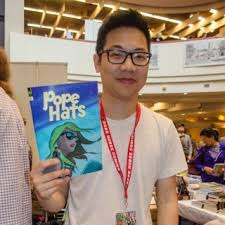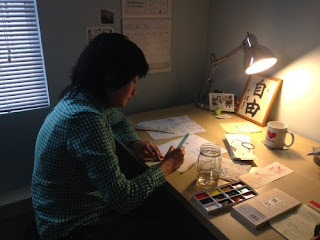I'll admit to being mischievous when I decided to review the comics of friends and faux-rivals Carta Monir and Carolyn Nowak in the same column, but any sense of self-amusement quickly faded when I engaged with their beautiful, heart-rending work.
Secure Connect, by Carta Monir. I've read many, many comics about the experience of trans people.. Some were direct, personal and informative. Some were funny as well, using humor as a way to defuse some of the pain of the transition process (and life before transition). No comic has given me the opportunity to crawl inside the brain and heart of a trans person the way that Monir's comic did. The conceit is simple: a trans woman is given a computer program by her therapist that will connect her with a highly intimate, virtual support group. It's one where raw honesty is its most important aspect. The comic follows one such session, two months after she received the program.

The support session was divided into three activities: share an image, share a fear, wear an image. One of the keys to the success of the comic was Monir's open-page layout that was designed to replicate the emotional and first-person experience of being in such a session as opposed to the reality (a person sitting at a computer screen). As such, there are close-ups of her eyes, zoom-ins on screens, fractured and iconographic imagery, imagery that repeats as the protagonist imagines and re-imagines them in her mind that looks like pop-up screens, and then more conventional page layouts when there's a sudden narrative aspect to the nature of their interactions. There are a lot of interesting formal elements at work here, but the reader doesn't really notice the scaffolding unless specifically looking for it. Monir's narrative is so compelling and immersive that the reader is simply taken along on the journey.
The first activity featured the women sharing highly erotically charged images that had different meanings. One shared an image of an ex, spread-eagle and masturbating--not as a deliberately provocative act, but to relate her own feelings of disgust and worthlessness. That said, Monir revealing has the protagonist react with desire when she sees each of the sexualized images. It's an interesting juxtaposition, even as the protagonist lies to the others on the call about certain things, Monir lays bare her every emotion, fear and desire for the reader. That especially plays out when the image the protagonist uploads is of herself from six years ago (complete with beard), but she cops out and says it's her ex. She even repeatedly says "I'm sorry" out loud. What I found fascinating about this and a later panel where someone (a potential date) calls, she declines the call and texts to say she'll call back and gets told "don't bother" is the way Monir depicts the push-pull nature of this kind of therapeutic relationship. It's not all hearts and flowers and empowerment. It's messy, raw and makes her frequently feel ambivalent, scared and awkward.
The fears section was entirely verbal, which made it far less intense and visceral than the other two sections but no less difficult. The protagonist talks about her fear of change, or rather a fear of making a big and irrevocably wrong change. I love the sense of antagonism she feels toward the moderator of the group, even as she comes to feel sympathy for her. The last section, "wear your image", was when the comic ironically turned into a more typically-composed page. Monir made sure not to make it a grid so as to keep the reader a little off-balance, but there are regular panels and gutters here. One person sees herself as a super-confident, sexual being. One wears the skin of a guy who essentially asserts the limits of his patriarchal power: the power of life and death. One is a horrible, insensitive beast. The protagonist is a slutty, creepy girl who deserves punishment, and the moderator presents an image of a baby with its hands chopped off, which the protagonist views as "tragedy porn" even as the moderator says it's "to raise awareness". The brilliance of the end is that there is no end; there was an outburst of emotion from the protagonist and kindness from the moderator in return, urging everyone to vent and feel in this space. The final pages are a meditation on the group's mantra: "I will remake myself in my own image", as the protagonist imagines stacked windows being reduced to a simple, blank slate that is in the end, a positive expression of self. It's not an ending, but a first step. Monir not only beautifully expresses her own individual issues as a trans woman, she also brings the reader into the experience of therapy itself, of confronting and evading one's issues, of learning how to be honest with oneself and others. The innovation of her page composition mixed with her clear-line approach makes the book both immersive and entirely clear.

Radishes and
Diana's Electric Tongue, by Carolyn Nowak. I first encountered the quirky, gentle and genre-inflected work of Nowak in an issue of the anthology
Irene. I was immediately impressed by the way she depicted the push-pull of aggression and attraction and the way she treated each character with humanity and empathy, even as they sometimes did bad things to each other. Beneath the flip and fantastical surface of the comic was a deep well of emotion. That was certainly true for her Ignatz-winning comic
Radishes, which is about two high-school age girls in a sort of fantasy setting. They decide to skip school one day and go to the big local market, where they have their run of the place because no one's there yet. One of the friends (Kelly) is tall, thin and confident, while her best friend (Beth) is shorter, plumper and passive. In a series of amusing anecdotes, the real story Nowak tells is how they take care of each other emotionally. Halfway through the story, they find a magical fruit stand whose produce causes them to float, lose their hair and eventually create a double. Kelly laughs off her own friendly double but Beth has a profound experience with hers, weeping as her double embraces her and Beth apologizes to her. It's a moment of profound self-actualization and forgiveness, of gaining a moment of self-acceptance and self-love. Everything Nowak does in the comic leads up to that one moment, and when it's over, the comic quickly ends. It was a powerful metaphor that didn't act as a blunt force object because of how seamlessly it was incorporated into the rest of the comic.

Diana's Electric Tongue takes on more complex themes. There's not much in the way of plot in this story, as Nowak's comics are more character pieces than anything. Instead, Nowak has the reader follow three distinct threads: 1) The fact that the titular character suffered a severe accident that saw her bite off her own tongue in the process, only to be replaced with a cybernetic version. The understated nature of the trauma of that event is a key part of the story. 2) Diana buys a companion robot that's attuned to each individual user; more than a sex robot (though that's part of ), it acts as best friend and confessor as well. 3) Diana is invited to a wedding where her famous ex will be present and decides to bring her robot, Harbor, to the event. Let's break down each thread.
One of the themes of the story is the intersection between physical and emotional trauma. One never gets the sense throughout the story that Diana has actually process her physical trauma. She has a new, fancy tongue, but it doesn't quite work right with regard to taste. The ways in which she tries to downplay this make it even more obvious that this is an issue she's simply chosen not to address. This plays a role in her choice to buy Harbor, who has therapeutic value in his "vault" mode, an uncrackable database for one's deepest secrets. Diana ostensibly bought Harbor to get over the pain of being dumped by her famous ex Blue, but that's only one of the kinds of pain she processes, until the very end of the story, when we see the accident occur, presumably in Diana's mind's eye. Another theme of the story is shame. Though her friends mock her for it, buying Harbor and bringing him to a public even was a signal from Diana that she was through with shame. It wasn't just a whimsical decision, as she crossed a very specific kind of line with her choice.

Nowak also obliquely addresses another idea, which is the difference between Diana's relationships with Harbor and Blue. It's no accident that Blue does not have a present-tense speaking role in the comic. He's famous. There's a sense in which no matter what his intentions with Diana might have been, there was no chance of real, lasting intimacy between them precisely because he chose to live in the stratified air of celebrity. There are ways in which Diana was far more intimate with Harbor than she ever was with Blue in terms of being able to tell him anything, Harbor's devotion and genuine adaptability to Diana's needs. That plays out when he makes up a poem for her that's incredibly lovely in its own way. At the same time, he has no free will or agency of his own. He wouldn't be there if she hadn't paid for him, in precisely the same way being with a sex worker or a therapist buys you their time and attention. The story is open-ended, but one gets the idea that Diana was perhaps on the way to healing by the end.
The story works well because of Nowak's skill and clear delight in drawing bodies. Diana is big-hipped, her roommate has big legs and everyone in the story has their own particular physical and real-feeling presence. The composition of her panels is frequently quite clever, with not just open page formatting but cutaways where the roof has been lifted off. She keeps the reader off-balance with big splash pages, using negative space to highlight a single panel on a page, and lots of close-ups on faces. Her use of color was spectacular, adding context to the futuristic world she created to make it inviting, exciting, and slightly trippy. She's also great at drawing facial expressions, like the perpetual blush on Diana's face or the blank but benign expression on Harbor's face. This is ultimately a story about survival and recovery, with Nowak's humanity shining through and comforting her characters without sacrificing the pain of their struggles.


















































